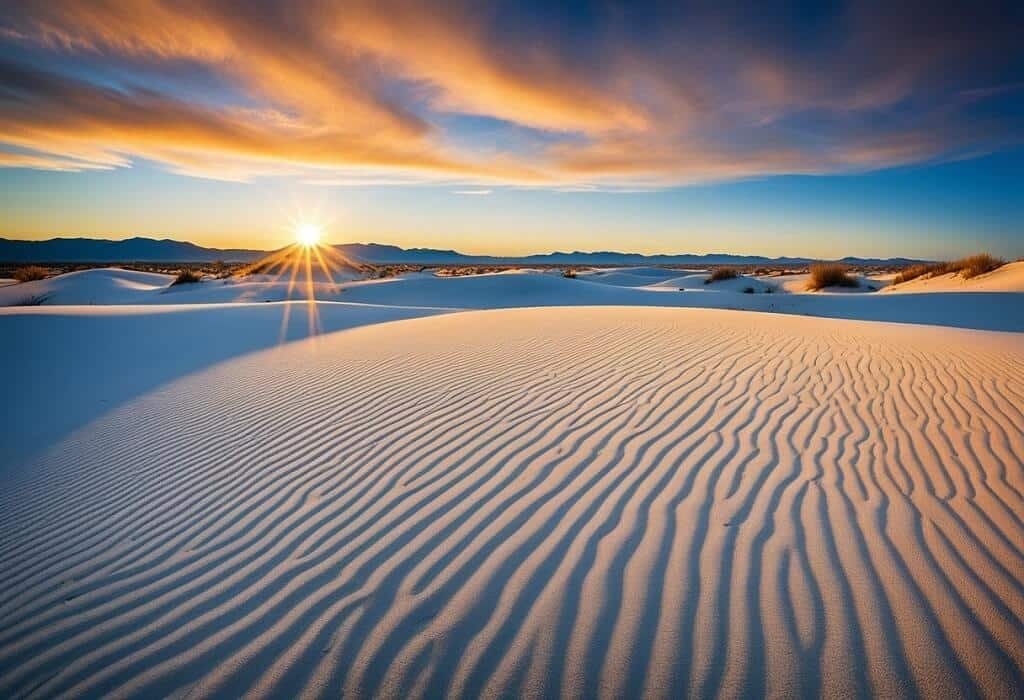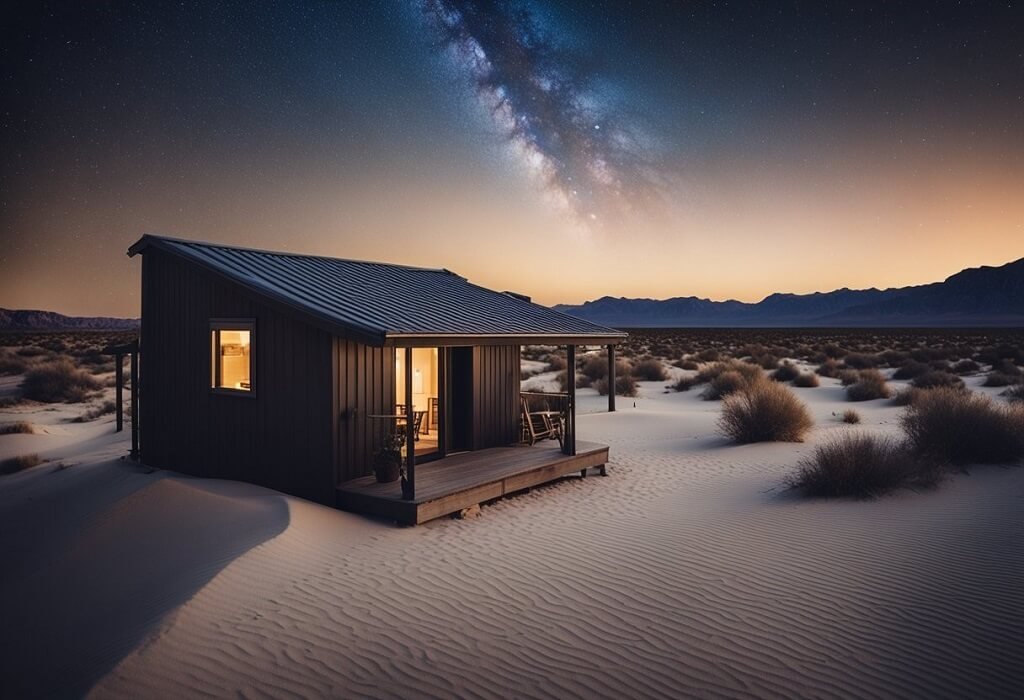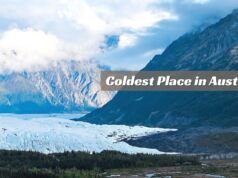Are you planning a trip to White Sands National Park but unsure when the best time to go is? As a travel enthusiast, timing is everything when visiting national parks.
In southern New Mexico, White Sands National Park is one of the newest national parks in the United States. With its stunning white dunes and unique landscape, it’s no wonder it’s quickly becoming a popular travel destination. But when is the best time to visit? Is it during the summer when the weather is warm, or in the winter when the crowds are thinner? Keep reading to find out.
In this article, I’ll share everything you need to know about the best time to visit White Sands National Park. I’ll cover all the important factors that will help you plan your trip, from the weather conditions to the crowds. By the end of this article, you’ll clearly understand when to visit and what to expect during your trip. So, let’s get started!
Ideal Times for Visiting White Sands National Park

The best time to visit White Sands National Park is during the Fall, Winter, and Spring months. The mild weather during these months makes it an excellent time to explore the park. The daytime temperatures are pleasant, and the crowds are much smaller than during summer.
Sand can burn during the summer months, and temperatures can soar. That may result in a wretched and even hazardous encounter. Going early in the morning or later in the evening is the best option if you visit during the summer to avoid the heat.
The rainy season is from July to September, and it can cause flash floods in the park. It is best to avoid visiting during this time, as the park may be closed due to the dangerous conditions.
Read: Hawaii Weather in March 2024
Weather Insights: Key to Planning Your White Sands Adventure
When planning a White Sands National Park trip, understanding the weather conditions is crucial. As someone who has visited the park several times, I know that the weather plays a significant role in the quality of your experience.
The good news is that White Sands National Park enjoys mild weather conditions throughout the year. However, the best time to visit the park is spring (March to May) and fall (September to November) when the temperatures are pleasant and the crowds are low.
During the day, temperatures can range from 65°F (18°C) to 85°F (29°C), making it perfect for exploring the park without getting too chilly or hot. It’s essential to note that the sand can get scorching in the summer, making it uncomfortable and sometimes dangerous to hike or explore the park. Therefore, it’s best to avoid the park during the summer months.
Another crucial factor to consider when planning your trip is the rainy season. The rainy season in White Sands National Park typically occurs between July and September, with August being the wettest month. During this period, thunderstorms can occur, making it challenging to explore the park. Therefore, avoiding visiting the park during the rainy season is best.
Avoiding the Crowds: When is White Sands Less Visited?
Planning your visit during the less busy times is crucial to enjoy White Sands National Park without the crowds. The fall months of October, November, and December are recommended, as these months see the lowest visitation, behind January, with under 100,000 people visiting.
During this time, the weather is mild, and the park is less crowded, allowing you to enjoy the dunes with fewer people around. January and February are the least busy months at the park, providing an opportunity to avoid crowds and save on lodging.
Yet, it’s essential to remember that the weather can be cold, so packing warm clothing is advisable. The park can become very busy during the summer, and the sand may be scorchingly hot, making hiking and other activities uncomfortable. March emerges as the best time for hiking in White Sands National Park, offering warm weather that is not excessively hot.
Read: Myrtle Beach Weather in March
Seasonal Highlights at White Sands National Park
If you’re planning a trip to White Sands National Park, you might wonder when to visit. As someone who has been to the park throughout the year, I know each season offers a unique experience.
During the winter months, the park is less crowded, and the cooler temperatures make it a great time for hiking. If you’re lucky, you can see the park covered in snow, which is a rare and beautiful sight.
One of the most popular times to visit the park is during a full moon. The park offers special ranger-led full moon hikes, which allow you to experience the park in a whole new way. The moon illuminates the white dunes, creating a surreal and magical atmosphere.
No matter what time of year you visit, you can participate in activities such as hiking and sandboarding. The park offers rentals for sand sleds and sandboards so you can experience the thrill of sliding down the dunes.
Activities and Their Best Seasons in White Sands
White Sands National Park offers a variety of outdoor activities throughout the year. Here are the top 8 activities and their best seasons to enjoy them:
- Hiking: The best time for hiking in White Sands National Park is in March, April, and May when the weather is pleasant and the sand is not too hot.
- Sunset Stroll: Fall is the ideal season for a stroll in the park at sunset because there are fewer people and fewer crowds overall.
- Backcountry Camping: The best time for backcountry camping is in the winter months, from November to February when the temperatures are cooler and more comfortable.
- Sledding: Winter, from November to February, is the ideal time to go sledding because there’s more snow on the dunes.
- Stargazing: The best time for stargazing is in the summer, from June to August, when the nights are clear, and the Milky Way is visible.
- Dune Life Nature Trail: When the wildflowers bloom from March to May, it is the ideal time of year to explore the Dune Life Nature Trail.
- Sunrise: The best time for a sunrise hike is in the fall when the temperatures are cooler and the park is less crowded.
- Ranger-led Activities: Throughout the year, the park hosts ranger-led activities such as stargazing sessions, full moon hikes, and guided hikes. For the most recent schedule, visit the park’s website.
Read: Best Time to Visit Kashm
Early Mornings or Late Evenings: What Works Best for Your Visit?
Visiting White Sands National Park, the best time of day is undoubtedly early mornings or late evenings. During these hours, the sun’s low position on the horizon casts long shadows and bathes the gypsum dunes in hues of pink and purple, offering a magical transformation that delights photographers.
For early birds, sunrise presents an ideal opportunity to experience the park almost in solitude, with the morning sun’s soft light creating a serene and peaceful atmosphere.
Strolling along the Dune Life Nature Trail or exploring the park’s unique ecosystem becomes a tranquil pleasure. The park remains open for night owls until 10 pm, allowing ample time to witness the sunset and admire the night sky.
Located far from city lights, it is an excellent spot for stargazing, where visitors can bring a telescope or binoculars to gaze upon the breathtaking views of the Milky Way.
Here are some things to keep in mind when planning your visit:
- The ideal time of day to visit White Sands National Park is late afternoon to early evening.
- During the summer months, it can get hot during the day, so visiting early in the morning or late in the evening can be more comfortable.
- If you plan to take photographs, the best time to capture the colors of the sunset or sunrise is 30 minutes before and after the event.
- The park can be crowded during the weekends and holidays, so visiting early or late in the evening can help you avoid the crowds.
Special Programs and Events Throughout the Year
Visiting White Sands National Park offers unique experiences through special programs and events held throughout the year. Ranger-led hikes and full moon nights stand out, allowing one to see the park in a different light.
The ranger-led hikes are among the most popular programs, offering insights into the park’s history, geology, and wildlife from knowledgeable rangers. Various hikes are available, ranging from easy strolls to more challenging treks, with the schedule and details available on the park’s website.
Experiencing the park’s annual events is another highlight. Full Moon Nights, featuring performances by local musicians and artists under the moonlight, create magical memories. The park also hosts special events like the White Sands Balloon Invitational and National Park Photography Symposium, enriching visitors’ experiences.
During full moon phases, the Full Moon Hikes are a must-do activity. Led by rangers on the night of the full moon, these hikes offer an unforgettable trekking experience through the dunes under the moon’s glow.
Read: When is the Worst Time to Go to Ireland?
Photography at White Sands: Capturing the Park’s Ethereal Beauty
The best time to take breathtaking White Sands National Park pictures is sunrise or sunset. The gypsum dunes look picturesque at these times, and the light is perfect for capturing the park’s awe-inspiring scenery. I recommend bringing your camera and tripod to capture the park’s ethereal beauty.
When taking pictures of the gypsum sand, consider using a polarizing filter to reduce the glare. This will help you to capture the sand’s true colors and textures. A wide-angle lens is also ideal for capturing the expansive dunes landscapes.
White Sands National Park’s white dunes are an excellent subject for photographers. The dunes’ soft curves and the way they reflect light make them captivating. The park’s scenic beauty is awe-inspiring; you can capture it with your camera.
Accommodation Tips: Where to Stay for Easy Park Access

If you want to stay close to White Sands National Park, your best bet is finding accommodation in Alamogordo or Las Cruces. Both cities are within driving distance of the park and offer various lodging options. Here are some tips for finding the perfect place to stay:
- Location: Look for accommodation within a 30-minute drive of the park. This will give you easy access to the park and allow you to explore more and drive less.
- Price: Consider your budget when choosing accommodation. While there are plenty of budget-friendly options in the area, you can splurge on a more luxurious hotel or resort if you’re looking for a more relaxing vacation.
- Amenities: Look for accommodation that offers amenities that are important to you, such as free Wi-Fi, a pool, or a fitness center. Some hotels even provide shuttle service to the park, which can be a convenient option if you don’t want to drive.
- Reviews: Read reviews from other travelers to get an idea of what to expect from the accommodation. Look for reviews that mention the proximity to the park, cleanliness, and helpful staff.
Some popular options for accommodation in Alamogordo include the Fairfield Inn & Suites and the Hampton Inn. Both hotels are within a 15-minute drive of the park and offer comfortable rooms and amenities.
You can find various accommodation options in Las Cruces, from budget-friendly motels to luxurious resorts. Some popular choices include the Hotel Encanto de Las Cruces and the Hilton Garden Inn. Both hotels are within a 1-hour drive of the park and offer easy access to other attractions.
Read: New Orleans Weather in March
Preparing for Your Visit: Essential Tips Across Seasons
Before you set out, knowing a few key details is important. The park brings great national pride, a natural wonder that must be respected. Here are some things to keep in mind:
- The park is open year-round, but the best time to visit depends on your preferences. If you’re keen to hike, the cooler months of October through April are ideal. If you’re more interested in barefoot walks on the dunes, the warmer months of May through September are better.
- The park is home to endless gypsum dunes, which can be difficult to navigate. Always check with park rangers before setting out, and ensure you have plenty of water and sunscreen.
- The park is home to wildlife, including yucca plants and small animals like rodents and lizards. Stay on designated trails, and don’t disturb the natural habitat.
- The park is in the desert, so preparing for extreme temperatures is important. Always wear sun protection and bring plenty of water with you.
Tips for Visiting in Different Seasons
Whether it’s spring, summer, fall, or winter, there’s always something to see and do in White Sands National Park. Here are some tips for visiting in different seasons:
- Spring: The mild and pleasant weather makes it a great time to explore the park’s hiking trails. The park’s yucca plants are also in bloom during this time, making for some stunning photo opportunities.
- Summer: Temperatures can soar during the summer months, so taking precautions against the sun is important. Stick to early or late afternoon visits; always carry plenty of water.
- Fall: Crowds are virtually nonexistent in the fall, making it a great time to visit if you’re looking for a quieter experience. The cooler temperatures also make for more comfortable hiking conditions.
- Winter: The park can be covered in snow during winter, making for a unique and beautiful experience. However, it’s important to be prepared for colder temperatures and to check with park rangers before setting out on any hikes.
Essential Items to Bring
- Sunscreen: The park’s high altitude and reflective sand can lead to sunburns, so it’s important to wear and reapply regularly.
- Water: Staying hydrated is important, especially during the hotter months. Bring plenty of water and a hydration pack or water bottle with a built-in filter.
- Hat and sunglasses: Protect your eyes and face from the sun’s rays with a hat and sunglasses.
- Comfortable shoes: The dunes can be difficult to navigate, so wear comfortable shoes with good traction.
- Trail map: Always carry a trail map with you, and check in with park rangers before setting out on any hikes.
With these tips in mind, you’ll be well-prepared to visit White Sands National Park, no matter what time of year you go.
Read: When is the Worst Time To Visit Bermuda?
How much does it cost to go to the White Sands National Park?
The entrance fee for White Sands National Park is $25 per vehicle for a 7-day pass. This fee covers everyone in the car, including the driver and passengers. However, if you plan to visit the park multiple times a year, purchasing an annual pass for $45 may be more cost-effective. This pass allows the pass holder and up to three adults in a private, non-commercial vehicle to enter the park for free for a year from the month of purchase.
It’s important to note that the annual pass can only be purchased at the entrance station to White Sands National Park. Additionally, there are no discounts for seniors, students, or military personnel. However, there are a few free entrance days throughout the year, so it’s worth checking the park’s website to see if your visit coincides with one of these days.
If you plan to camp at White Sands National Park, there is an additional fee of $10 per night for a backcountry camping permit. The park also offers group campsites, which can accommodate up to 20 people, for $3 per person per night.
Frequently Asked Questions (FAQs)
What is the absolute best time to visit White Sands for mild weather?
The best time to visit White Sands National Park for mild weather is in the spring, particularly late April and early May. During this time, temperatures are mild, and the wildflowers are in full bloom, making it a perfect time for hiking.
How much time do I need at White Sands National Park?
You can see most of the park’s main attractions in a half-day visit, but I recommend spending at least one full day to fully appreciate the beauty of the dunes and the surrounding nature.
How long does Golden Hour last?
Golden Hour at White Sands National Park lasts 30-40 minutes before sunset and after sunrise. This is the best time for photography, as the sun casts a warm glow on the dunes, creating a stunning contrast of light and shadow.
Can I experience the park after dark, and if so, when?
Yes, you can experience the park after dark during the full moon nights, which occur once a month. The park offers a guided full-moon hike that takes visitors on a two-mile trek through the dunes, providing a unique experience of the park’s natural beauty.
Are there any months when access to White Sands is restricted?
Access to White Sands National Park is not restricted throughout the year. However, some facilities and activities may be closed or limited during winter, so it’s best to check the park’s website for updates.
How do I stay safe and comfortable during the peak heat of summer?
To stay safe and comfortable during the peak heat of summer, it’s best to visit the park during the early morning or late afternoon when temperatures are cooler. Wear light-colored, loose-fitting clothing, and bring plenty of water to stay hydrated.
What’s the likelihood of encountering a sandstorm, and how should I prepare?
Sandstorms are rare at White Sands National Park but can occur during the monsoon season from July through September. If you’re visiting during this time, it’s best to check the weather forecast and be prepared with appropriate clothing and gear.
Does White Sands offer engaging activities for children throughout the year?
Yes, White Sands National Park offers engaging activities for children throughout the year, including ranger-led programs, Junior Ranger activities, and the popular dune sledding.
Which season offers the best lighting for dune photography?
The best season for dune photography at White Sands National Park is during the spring and fall when the sun’s angle is lower in the sky, creating long shadows and highlighting the texture of the dunes.
Are visitors allowed to bring pets to White Sands?
Pets are allowed in designated areas of the park but must be kept on a leash at all times. Pets are not allowed on the dunes or in the backcountry.
What do I need to know about securing a backcountry camping permit?
Backcountry camping permits are required for overnight stays in the park’s backcountry areas. Permits can be obtained at the Visitor Center, and making reservations in advance is recommended.
How can I enjoy White Sands National Park while avoiding large crowds?
To avoid large crowds, visiting the park during the off-season months of November through February is best. Additionally, staying on weekdays instead of weekends can help avoid crowds.
Can you swim at White Sands?
Swimming is prohibited at White Sands National Park, as there are no bodies of water in the park.
Can you just drive through White Sands National Park?
Yes, you can drive through White Sands National Park, but I recommend getting out of your car and exploring the dunes on foot to appreciate the park’s natural beauty fully.















